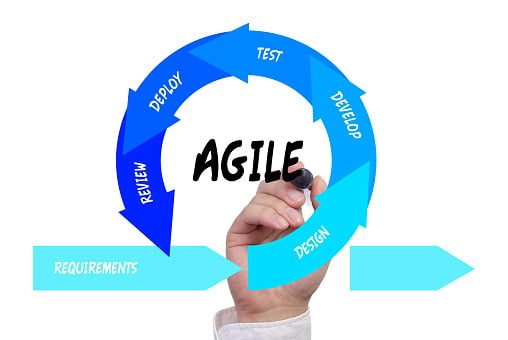Agile Marketing Turned Into Agile Sales & Now Agile Revenue Generation
The Pace Of Change In Marketing And Sales Is Accelerating: What Are You Doing About It?
 None of us can get to every conference, but when I have the pleasure of attending one of the year’s best conferences, I like to share those experiences with all of you.
None of us can get to every conference, but when I have the pleasure of attending one of the year’s best conferences, I like to share those experiences with all of you.
I recently returned from one of the best conferences, SiriusDecisions’ annual summit in Austin, Texas. This is my second time attending and our agency’s third. This is the first time we exhibited. What I love about this conference is the high level of attendee (CEOs, CMOs and VPs of both marketing and sales) and a heavy focus on technology solutions.
What I also love about this conference is the level of thought leadership shared by the SiriusDecisions team. If you don’t know this company, I like to refer to them as the Gartner of sales and marketing.
You might not be surprised to hear that this year their focus was on sales and marketing alignment, sales operations and Agile sales. All three of these elements are now presented as keys to driving revenue.
Marketing And Sale Alignment
The first component is going to seem obvious to most of us. We’ve been preaching the importance of aligning both sales and marketing since we wrote Fire Your Sales Team Today! and introduced the concept of the revenue department in 2012.
Sales Operations
Sales operations is a more recent concept. Google the term “sales operations” and you get a January 2018 post from Sales Hacker. I’m a big fan of these guys; you should check them out.
They define sales operations as the “unit, role, activities and processes within a sales organization that support, enable and drive front-line sales teams to sell better, faster and more efficiently.”
Through strategically implemented training, software tools and engagement techniques, sales ops enable sales reps to focus more on selling to drive business results.
But perhaps more than anything else, sales operations brings a system to selling. This often-overlooked and sometimes-under-accounted-for effort uses data to drive strategy, best practices to guide training and technology to hack success.
To be clear, this is not sales coaching, sales training or even sales execution.
Agile Sales
 Finally, Agile sales. First there was Agile software development, then Agile marketing and now Agile sales. What do we mean by Agile sales?
Finally, Agile sales. First there was Agile software development, then Agile marketing and now Agile sales. What do we mean by Agile sales?
In the traditional world of sales, selling methodologies often included a rigorous process of prospecting and discovery sessions plus a flurry of emails, phone calls and dinners that were chalked up as “relationship-building” events.
But in today’s modern sales age, traditional methods on their own can no longer cut it. According to CSO Insights, only 57% of sales reps hit their quotas, with the average company coming at 80% of the revenue plan.
A couple of concepts are required for sales to be Agile.
Data Driven
What transformed the software development industry was the ability to get user feedback instantly and make development decisions based on that user feedback. Minimal viable product now meant getting something done and out, grabbing user feedback and making changes based on that feedback quickly.
Instead of waiting years for something to be perfect, software teams published their newest version and made live adjustments to it based on real customer feedback.
Marketing has become a similar practice. Instead of waiting months for a huge new website, get a minimal viable site up quickly, get visitor feedback and work on the site every single week.
Instead of waiting months to get the campaign assets perfect, get your campaign up and out, watch the data, change the message, offer and other campaign variables based on real-time data and drive better results.
Sales can work in a similar way. Create a process, build the tools and train the sales team. Then work closely with them on the execution, track the performance data, get feedback from the field and iterate all of those components over time. The business outcome is better results faster because the changes are driven by your prospect’s behavior and data, not by internal opinions or perspectives on hypothetical process changes.
Constant Iteration
Set it and forget it. That used to be how you managed your sales process. In some cases, your sales process might be 10 years old. Those days are over. At Square 2, we iterate our own sales process almost every single week based on prospect feedback, data from our CRM and the success of our own efforts.
You should be doing something similar, and that’s where sales operations becomes critical.
Sales leadership should constantly be working several quarters in advance to spot trends, mitigate procedural issues and work collaboratively with other teams to generate qualified leads and nurture existing opportunities through the sales cycle.
Without marketing, customer success, procurement, IT and even implementation teams working in sync, Agile selling doesn’t work — it simply cannot be effective if sales is operating in a silo.
But by identifying patterns, targeting trouble spots, analyzing the data, collecting prospect feedback on the process and working with other teams in an ongoing manner, sales can make tremendous strides toward being Agile.
Prospect/Customer Alignment
You can’t just do what you want or what you think is right. Your sales process has to be based on what your prospects and customers want and/or need.
Access to information like content, websites, videos and information on your company means your prospects are coming into your process much smarter than they’ve ever been before. You can’t sell them anything.
Instead, your sales process must be designed to find out early whether alignment exists between what they want and what they need with what you have to offer them. It has never been more important to decide in the very first call or conversation whether there is not a fit.
Some of the best sales processes we’ve designed for clients are specifically built to disqualify prospects early, so sales reps get to spend quality time with their best prospects and their best opportunities to drive revenue. Efficiency of the sales process is incredibly important.
Then the rest of the process needs to be strategically designed to align perfectly with their buyer journey. Today, more people are involved in the purchase decision, with Harvard Business Review reporting it’s 6.8 people on average. How is your sales process designed to proactively engage multiple people? How is it designed to identify them? How is it designed to align them around your solution?
You must understand each specific prospect’s buyer journey. In some cases, you might have different prospect buyer journeys based on industry, role, product or service. These are as unique as your DNA and should be treated accordingly.
When this alignment is realized, your prospects experience a very personal set of interactions with your company that quickly get them to feel comfortable, which shortens their sales process and increases your close rate.
Process And Tools
 HubSpot recently reported that companies in North America are already spending more than $15 billion on sales acceleration tools, and HubSpot’s own Scott Brinker shows that there are now over 7,000 marketing and sales tech tools.
HubSpot recently reported that companies in North America are already spending more than $15 billion on sales acceleration tools, and HubSpot’s own Scott Brinker shows that there are now over 7,000 marketing and sales tech tools.
Plenty of options exist when it comes to sales software, but companies are clearly uncertain about which tools to purchase, how to deploy them, what to expect and how to optimize their performance to drive business results.
HubSpot also reported that only one-third of a rep’s day is actually spent selling, with most of their time being allocated to admin work or CRM data entry.
This is not efficient and this is not what you want. Processes, systems, methodologies and software tools can help make your reps highly efficient and much more effective.
In our experience, most sales organizations are looking at software simply from the CRM perspective. If they have one, they’re done. The reality is that today, many different sales acceleration software tools need to be worked into the Agile approach to sales, and more specifically, handled by the sales operations team.
If you want take a more Agile and iterative approach to sales, you’ll need your sales process defined, documented on paper and built into your CRM. You’ll also need your sales team well trained on each step and your prospect buyer journey properly mapped. You should then be looking for software that helps your sales team execute as efficiently as possible.
For example, can follow-up emails be automated? They can, and they can be highly personalized. Can conversations be captured and analyzed by software so that next steps and content offers are suggested to reps in real time? Yes, they can! Can leads be scored and then the process directed by those scores to ensure sales reps spend the most time with your best opportunities? Yes, they can!
Software alone doesn’t generally solve all of your challenges, but combined with people and process, you can make major improvements in all of the key sales metrics (specifically sales cycle and close rate).
These tools also give you the data you need to make fast decisions, to iterate quickly based on data and to drive sales performance improvement in weeks, not months or quarters. It becomes the backbone of any Agile sales effort.
You should be able to see how critical the sales operations team, the sales operations role or using an agency to support your sales operations is to hitting or even exceeding your revenue goals.
With so many companies missing their sales goals on a regular basis, this missing element of their sales execution is often the hidden reason behind underperforming sales teams.

CEO and Chief Revenue Scientist
Mike Lieberman, CEO and Chief Revenue Scientist
Eliminate Hit-or-Miss Marketing Moves
Get advice, tips, tools and guidance to generate more leads for your company in this weekly email newsletter.



Eliminate Hit-or-Miss Marketing Moves
Get advice, tips, tools and guidance to generate more leads for your company in this weekly email newsletter.













